Fort Belknap Agency
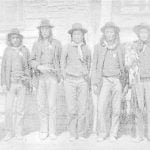
The report of Special Agent Jere E. Stevens on the Indians of Fort Belknap reservation, Fort Belknap agency, Montana, December 1800. Names of Indian tribes or parts of tribes occupying said reservation; (a) Assinaboine and Gros Ventre.
The unallotted area of this reservation is 537,600 acres, or 840 square miles. This reservation has not been surveyed. It was established, altered, or changed, by treaty of October 17, 1855 (11 U. S. Stats., p.657); unratified treaties of July 18, 1866, and of July 13 and 15 and September 1,1868; executive orders, July 5, 1873, and August 19, 1874; act of Congress approved April 15, 1874 (18 U. S. State., p. 28); executive orders, April 13, 1875, and July 13, 1880, and agreement made January 21, 1887, approved by Congress May 1, 1888 (25 U. S. Stats. page 113).
Indian population 1890: Assinaboine, 952;, Gros Ventre, 770; total, 1,722.
Fort Belknap Reservation

The agency of this reservation is located on the south bank of the Milk River, 4 miles south of Harlem, a station on the line of the Great Northern railway and the nearest post office. The agency has been located here about a year, having been removed from the old site when the reservation was reduced in size.
The Assinaboine live principally along the Milk River, which forms the northern boundary of the reservation, while the greater number of the Gros Ventres live in and near the mountains which form the southern boundary of the reservation, there being a distance of about 30 miles between the two settlements. These two bands are very different in their nature and disposition, have not intermarried to any great extent, and seem to have little interest in common. The Assinaboine are like their brethren of the Sioux tribes on the south, and in years gone by have caused more or less trouble to the white people. The Gros Ventres since their occupancy of the northern country have always the friends of the white man, and the Indians themselves take special pride in stating that their band has never injured, a white man.
They were driven to this country years ago by the Arapahoe, to which tribe they claim to have belonged at one time, being ‘unwilling to join in their ceaseless warfare and pillaging expeditions. They can be classed as peaceably disposed.
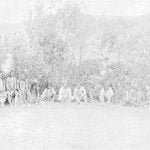
The agency buildings are all new and commodious, having cost about $65,000. They consist of dwellings for agent and employees, offices, medical dispensary, carpenter shop, blacksmith shop, meat house or market, 1 huge warehouse, besides a barn and outbuildings. In addition to these is a commodious and well-arranged slaughter house, where beeves are killed, dressed, and prepared for issue to the Indians, The custom of having the Indians witness the killing is no longer allowed, and, like time Indians at other reservations, they deem it a great hardship to be deprived of the privilege of carrying away the, “fifth” quarter, or entrails.
But few of these Indians can be said to have any occupation, as there is no longer game in sufficient quantity to afford profitable hunting, and, owing to repeated dry seasons and crop failure, but few of them attempt farming. Some are beginning to take an interest in tickling and have a few cattle, while others work at odd jobs. There is but little work for them more than the freighting necessary for the agency and the mission schools located on the south side of the reservation near the Little Rocky Mountains.
About one-fourth of these Indians are “blanket” Indians, although nearly all carry about their persons, especially during the cold season, a blanket in addition to the garb of civilization. The women are particularly averse to wearing anything upon the head, always depending upon the blanket to protect them from cold about the head and shoulders. In this their blankets serve a double purpose, as they always carry their children upon the back; in fact, almost anything they have to carry is either suspended from a strap that crosses the forehead or shoulders or is held fast to the shoulders by means of the blanket which they firmly clasp in front. One seldom finds an Indian, especially among the Sioux tribes, who does not prefer the blanket, which is particularly gay in color and figure, even though it be of inferior quality. This affords an excellent opportunity for traders to swindle them. Shirt, coat, vest, and trousers are all the garments of civilization that most Indians will wear. Nearly all of them still wear their hair long and prefer a red handkerchief over the head rather than the warmest cap. For foot wear they all use moccasins. The shoes that are issued to them they do not like, and will often cut the tops off to make moccasin soles, while the bottoms, or sole leather, they do not use at all, claiming that they can not walk with a stiff-soled shoe. They still retain their admiration of trinkets and beadwork, and nearly all have about them something of this kind. Many also wear feathers in their hair, some with the tail of a fox, rabbit, skunk, or other animal fastened to their long, braided locks. The only reason they do not wear so many of these savage decorations now as they once .did is because they are more difficult to get.
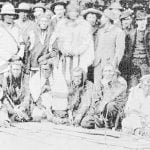
These Indians do not paint themselves as much as formerly, owing to the determination of the agent to stop the Custom by refusing to notice them if they appear before him with painted faces. They still follow the custom, while in camp.
There are but very few of these 1,722 Indians who use a word of English, all replying to interrogatories with the same characteristic grunt. Some of them, especially the half-breeds and younger Indians, who work around the agency, could speak enough English for ordinary intercourse if so inclined. The system of carrying on a. conversation by means of an interpreter with those who can speak English should not be countenanced by the agents.
The only day school on this reservation is a small one at the agency, which is attended by but few of the Indian children, the scholars being principally the children of the white people who are connected with the agency.
The mission school at this agency is situated at the mountains, about 35 Miles south of the agency buildings.
There are 2 new buildings one-half mile from the agency, which are intended for school purposes. The buildings, constructed of brick made on the reservation, at a cost of $20,000, will properly accommodate about 150 pupils. One great drawback to this agency is the poor water supply, the only good water that can be obtained being from a spring several miles distant.
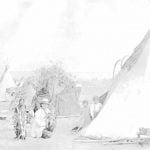
Assinaboine Sioux and Gross Ventre Home Life, Tepees covered with Cloth
The dwellings of these Indians are uncomfortable, unhealthy, poorly ventilated, and filthy log huts, generally about 12 by 14 feet in size, with dirt roofs and no floors. These are the winter habitations. In summer many live iii the canvas-covered tepee, which is more comfortable and healthy than the ordinary Indian house.
These Indians subsist almost wholly on the rations issued by the government, although some of them earn a little money occasionally by work or the sale of buffalo horns, which they patiently finish and polish while sitting around the camp fire. A good pair of these horns, well finished and finely polished, will generally bring about $1; but for the money thus obtained these people are apt to purchase some useless trinket that strikes their fancy or spend it for liquor, sugar, or tea.
The quality of the rations issued is excellent, in fact as good as the neighboring whites purchase for themselves. The flour is a good family flour; the beef is the Montana range meat; the pork is clear side bacon, and the granulated sugar is a prime article. The rice and coffee are also good. The soap can not be called a very good article, however, that is something little used by these people, but generally eaten by the half starved dogs.
The issue of rations at the Belknap agency occurs every Saturday.
It would seem that the issue table would be a good place to teach these people something about neatness and manners. It would perhaps be better to issue at longer intervals and take more pains in the manner of issuing, than to have these people gather once a week to scramble for food like a lot of hungry swine. Even though it take doable the force of help and more time, every article should be weighed out and properly done up before being issued. In this-way the young men and women of the tribe, could be taught to weigh and do up the various articles, all of which would certainly have a tendency to help these people and prepare them, to provide for themselves in the future.

Squaw with her family in the foreground
The issue of “annuity goods”, represents about $35,000, including about 40 wagons and as many sets of harness, or an average of about $20 for each man, woman, and child belonging to the reservation. Previous to the day of issue the issue clerk has a list prepared of just what each person or family is to receive, the object being to distribute as nearly as may be according to the value of the goods. The issue room is stocked with a supply of each kind of goods, and a score of assistants are employed to deal out the various articles as they are called off. Now let us suppose that ticket number 20 is presented, a certain number of dollars’ worth of goods having been allotted to that number. First, the bolder receipts for his annuities, or “touches the pen,” as they call it; then the issue clerk commences to call off the articles that have been assigned to that number, somewhat as follows: 1 blanket, 3 quilts, 1 suit man’s clothes, 1 suit boy’s clothes, 1 cap, 1 pair man’s shoes, 1 boy’s overcoat, 1 shawl, 1 pair girl’s shoes, 1 pair suspenders, 1 camp kettle, 3 tin cups, 1 coffee pot, 1 fine comb, 1 coarse comb, 1 paper of needles, 1 knife and fork, 1 pan, 1 tin plate. The first thing issued is always a blanket or a quilt, and this being spread out on the floor all the other articles are thrown promiscuously upon it until the amount the ticket calls for, has been issued; then it is dragged out into the dust and dirt, where the articles are inspected by the carious family. If the suit of clothes or overcoat happens to be a 40 in size and the man 36, or vice versa, he is expected to find some one else who is in the like dilemma mid make a trade with him. The same rule will apply to shoes, shirts, caps, mittens, or, in fact, to anything that is issued, and the Indians often trade off these annuity goods at a disadvantage. There are always white traders around who are ready to accommodate an Indian who has anything to barter, and certainly the latter will not gain anything by the trade he makes with these men.
There are often three times as many applicants as there are articles of certain classes (for instance, wagons and harness) to be distributed, making it necessary for the agent to decide between several persons who have equal right to consideration.
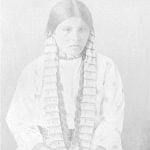
The older ones are more robust than the rising generation, and particularly is this the ease with the mixed bloods. Consumption, scrofula, and other diseases of that nature seem to have a hold upon them. The Indians’ dance is not measured by any given number of changes or limited to any given time, but rather by their vitality, and they often dance until they fall from exhaustion, when they are carried out to cool off and recuperate. This in itself seems to be sufficient to account for any amount of lung trouble that is found among them.
It is very difficult for the agent or agency physician to get reports promptly of any death that occurs, as the name of any deceased person is taken from the ration roll of the family as soon as reported; but, on the other band, as soon as a birth occurs it is known at the agency at once, as that increases the family food by 1 ration. In this matter these Indians show quite as much sharpness as their white neighbors could under like circumstances.
The reservation is about 29 miles square, being 312 acres of land for each man, woman, and child belonging to it, Only a very small portion of it can be classed as agricultural land, probably not to exceed one-tenth part of it, and even that is sure to produce a crop only about 1 year in 5, owing to the lack of rainfall and to the hot and parching winds that sweep these prairies every year, often caring the native grass in a single day.
More than one-tenth of the reservation could be plowed, probably one-fourth of it, but only that part lying close to the river and a few small tracts in the mountain valleys could produce a crop without irrigation, which is entirely out of the question, unless a water supply can be obtained by means of artesian wells, the Milk river being hardly sufficient to supply the stock with water.
Very nearly all of this reservation is good grazing land, rich feed growing in abundance all over its hillsides and valleys.
There is some fairly good pine timber in the mountains on the south side of the reservation, probably enough, to furnish the lumber necessary to build more comfortable houses for these people.
In their present location the only business they can profitably engage in is stock raising. It has been fully demonstrated that if they depend on grain raising they will suffer untold hardships and privations when thrown upon their own resources.
The agricultural implements issued to these Indians consist of mowers, hay rakes, plows, harrows, garden rakes, hoes, axes, and a few hatchets. There are 2 thrashing machines in the warehouse at the agency, which are but little used.
All these people are addicted to the vice of gambling, even the women indulging in the habit. They have an uncontrollable appetite for liquor, winch they manage to gratify in spite of the stringent laws against selling it to them. There are always evil-disposed white men about these reservations, who cause more or less trouble in this direction, and the Indians are particularly unfortunate in having no division between them and the land occupied by these white men other than a small stream that can be forded at any point. There are several little shops, along this stream where a few groceries are kept for sale or trade, and where liquor is openly sold to white men. One trader had at one time in his possession 300 pounds of coffee that had been issued to the Indians by the government and had been obtained from them in exchange for goods. These Indians do not seem to regard their old people as of any account; Probably the greatest immorality that exists among them today is the social evil, in which they are also largely the victims of an inferior order of white men.
Little or no advance has been made by them in civilization during the past 10 or 15 years. With the, advancement they have made in dress they have retrograded socially, and some of them have fallen to a very low scale. It is said by men who have been familiar with these people since 1864 that these Indians, especially the, Gros Ventres, up to the time of the extinction of the buffalo were a virtuous and a chaste people, death being the tribal punishment to the one who violated the marriage vows, and he who made any improper overtures to one of their women did so at the risk of his life. With the extermination of the buffalo and other game came a time of privations and hardships; and the Indian maiden’s favor had a money value, especially near military posts, and it was no uncommon thing for men to sell their wives, sisters, and even mothers, for immoral purposes.
Owing to the pressure brought to bear upon them by the government, these Indians have not had a “sun dance” for several years, but they still have some of their old dances, the favorite now being the “tea dance”, Where as many as possible gather in a room around a tire, over which is made a large quantity of tea of the vilest and most poisonous sort. The Indians drink this tea in large quantities, and always as hot as can be swallowed and dance around the boiling kettle for hours at a time to the weird music of a tom tom or Indian drum until they are completely exhausted; then they go out and suddenly cool off, thus inviting disease and death. He who can afford to give this feast is a great man in the estimation of his red neighbors. These occasions always furnish an opportunity for the men to recount their great deeds.
Most of these Indians carry about their person a belt full of cartridges; but few carry guns, although they all have them. It is no uncommon thing to hear the white people in this vicinity say they dread the coining of spring on that account; but there is little cause to anticipate any trouble at this reservation, especially from the Gros Ventres.
